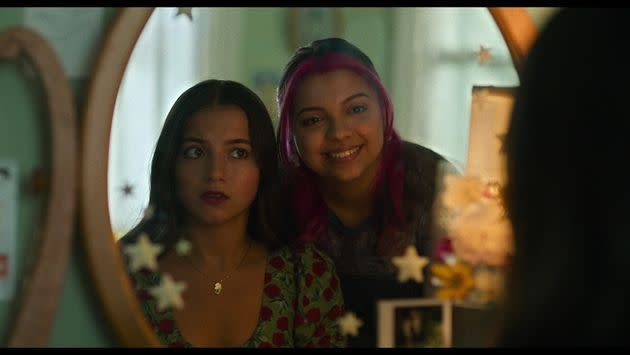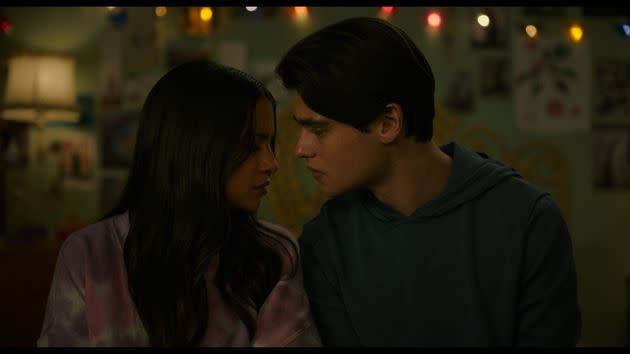'Turtles All The Way Down' Is A Moving Portrayal Of Life With A Mental Illness
Molly Turpin first read John Green’s young adult novel, “Turtles All the Way Down,” in 2018 when she was in an inpatient psych ward for treatment of obsessive-compulsive disorder. It was an emotional read because of how strongly she related to the novel’s protagonist, Aza, and her struggles with OCD and anxiety.
“[I] was so moved by John Green’s portrayal of OCD because it was the most accurate portrayal I’ve seen in media,” Turpin, now 27, said.
For many fans, like Turpin, Green’s novel feels personal. Whether they have a mental illness themselves or love someone with one, Aza’s story makes them feel seen and understood. This sentiment isn’t unique to “Turtles All the Way Down.” Green is known for writing stories — including “Looking for Alaska” and “The Fault in Our Stars” — about young adult characters grappling with a very specific scenario. In “Turtles All the Way Down,” Aza is searching for a missing billionaire who happens to be the dad of her crush, which ultimately leads to an internal revelation that touches at the very core of what it means to be human and to grow up. The love people have for these coming-of-age stories has resulted in a passionate fan base of readers who see themselves in the grace that Green’s books offer.
This is especially true for fans of “Turtles All the Way Down,” with many pointing to the text as a key event in their mental health journeys. The deep attachment those fans have felt to the book has increased expectations for its new movie adaptation, which is directed by Hannah Marks from a screenplay by Elizabeth Berger and Isaac Aptaker and stars Isabela Merced as Aza. But can the movie really be as good as the book? Can it do justice to Aza and every reader who has felt like her or loved someone like her?
The overwhelming consensus from fans is yes. The “Turtles All the Way Down” movie is a moving, accurate portrayal of what it feels like to live with a mental illness.
Shannon Parry was diagnosed with OCD in the second grade. Like Turpin, Parry, now 34, was really struggling when she first read “Turtles All the Way Down.” In 2017, she was in therapy, and she credits Green’s novel with helping her as much as therapy did.
“It was a matter of understanding that there were people out there in the world [like me] and [giving] me a language to be able to describe my OCD to the people around me,” Parry said.
A large reason for that was the imagery and language that Green uses in the book to describe Aza’s thought spirals, which are a series of negative thoughts, feelings or actions that can escalate and become overwhelming.
The trademark orange spiral on the cover, the allusion to a Raymond Pettibon painting of a spiral and the descriptions of Aza’s illogical but inescapable thought patterns all helped Parry.
“I was able to describe thought spirals and point to certain imagery in the book and say that is what it feels like when I’m going down a thought spiral or I can’t get out of a series of thoughts,” Parry said.
Patrick McGrath, the chief clinical officer for NOCD, an online platform that Green is partnering with because of its commitment to make exposure and response prevention therapy (the gold standard of OCD treatment) more accessible, said that everyone has intrusive thoughts, images or urges that interrupt their daily lives.
For example, everyone could drive over a bridge and think to themselves, “I wonder what would happen if I drove off of it,” but “the difference between people with and without OCD is that people without OCD can go, ‘Oh, that was weird’ and move on, and people with OCD can get caught in a thought spiral ... then they do some kind of compulsion … to neutralize the intrusive thought or image,” McGrath said. He said this compulsion makes people with OCD feel safe, and they think that if they had not done that neutralization, something terrible would have happened.

In “Turtles All the Way Down,” Aza’s intrusive thoughts are usually about germs, bacteria and her microbiome because she is terrified of getting an infection and dying. One of the ways she neutralizes this obsession is by fixating on the calloused pad of her finger: putting a band-aid on it, picking at it until it bleeds and cleaning it with soap or hand sanitizer.
When Parry first saw Aza’s flashing, interrupting thoughts about microbes in the movie trailer for “Turtles All the Way Down,” she cried. On May 2, the day the film was released on Max, she woke up in the middle of the night to watch it and cried again.
“The scene where I knew this movie fully understood and represented me was the first time Aza thought spirals about her cut,” Parry said. “The way the germs flash and she can’t stop thinking about the bandage. I go through something similar with my dermatillomania, or skin picking.”
Because most depictions of OCD focus on people’s compulsions, McGrath, who has seen the film twice, believes it is especially important that the movie shows “the mental stuff” because “finally people will understand that internal torture that occurs with obsessive-compulsive disorder.”
Kayla Miller, a 21-year-old college senior living in Indianapolis (where the film takes place), doesn’t have a mental illness herself, but she also thinks the movie can help people understand the challenges of supporting someone with one. She appreciates the way it shows Aza’s complicated relationships with Daisy (Cree), her best friend, Davis (Felix Mallard), her crush, and her mom (Judy Reyes).
“People are affected by the mental and physical health of others that they love, too,” Miller said. She found the film to be affirming of the experiences that she’s been through with family members who deal with depression, anxiety and addiction.
Parry said the book helped her parents “to understand in a very tangible way how I experience the world” and thinks the movie can do the same. As soon as she finished watching it, she tweeted, “…Texted my parents that, though my OCD is different than Aza’s, they should watch the movie to understand how I experience OCD.” Shortly after posting, Green retweeted her, saying, “This is our dream for the movie — that it can help not only people feel seen but also be a window for those who love and support people living with OCD and/or anxiety. (Plus, it’s funny.)”
When Green retweeted Parry, she felt like it made her leap to be vulnerable — she wouldn’t normally tweet something like that — worth it. It also emphasized that while the book and movie are a form of entertainment, they are also part of a bigger movement that Green has led to destigmatize mental illness.
Green has been very open about his own struggles with OCD and how a particularly rough period in his life inspired “Turtles All the Way Down.” Every fan interviewed for this article referenced Green’s openness about his mental health, saying it was inspiring and a contributing factor in why they were comfortable sharing their stories for this piece. And all of them hope that, like Green, they can use their experiences to help others know they aren’t alone and work to normalize broader conversations about mental illness.
This is the reason that Ellie Bridges Greenfield read “Turtles All the Way Down” in the first place. It was a summer reading assignment before her sophomore year of high school, included as part of a larger initiative to destigmatize mental illness. When she first read the book, Greenfield didn’t know about her own mental health issues. She could empathize with Aza, but she couldn’t understand her yet. It wasn’t until a few years later, during her first year of college, that Greenfield received a diagnosis of anxiety and began therapy, leading to her empathizing with Aza more deeply.
Like Aza, Greenfield feels like she is still at the beginning of a long journey. Her symptoms have been worse this spring, and she just started medication for the first time. She hasn’t even told her closest family or friends how bad things have been because she’s still learning to accept and manage her anxiety for herself.
For some, like Greenfield, the movie wasn’t an enjoyable watch because the thought spirals were triggering. While she thought it did a good job of depicting what it’s like to have a thought spiral, she was uncomfortable during those scenes because she knows how upsetting it is to experience something like that.

Although Greenfield thinks she will only watch “Turtles All the Way Down” once, she appreciates how hopeful its ending is.
“There is this element of acceptance that we see at the end of the movie that I think is so true,” she said. “Your thoughts are there, but they don’t control you ... and that’s something I always have to remind myself. At the end of the day, I have to remember I have mental authority.”
Without spoiling anything, the ending doesn’t downplay or sugarcoat Aza’s reality as someone with OCD or the challenges it may pose for her in the future. Instead, it reflects something McGrath hopes his patients can learn: mental illness will always be a “constant companion” for the rest of your life, but you can learn to live with it and it can be managed.
The final scene was also Turpin’s favorite part of the movie.
“[When] Daisy is telling Aza that she can be successful and she can build her life, and there will be times when it will be unbuilt but she’ll build it back up … I have found that is accurate in my own life,” she said.
Miller also loves the movie ending with this lesson, finding it hopeful and applicable to everyone — whether they have a mental illness or are supporting someone through one.
She also thinks the film, like the book, is comforting, saying that it’s “a safe place to land, to know that you’re going to struggle and you are going to face some hard things, but in the end there is still love, hope and people to support you through that.”
For these fans, the “Turtles All the Way Down” movie successfully captures the lived realities of being a teen and having a mental illness. But, most importantly, it is a testament to the larger impact of Green’s openness surrounding his own journey with OCD and anxiety.
For Parry, Green has created a world “where it is OK to do something like have an interview like this and share about your own mental health, and it’s OK to have OCD [and be a] skin picker. It doesn’t make you less than or unworthy … and that in fact, by coming forward, you’re probably helping someone else.”
Taken this way, “Turtles All the Way Down” begins to take on a new meaning. Maybe intrusive thoughts and anxieties do beget another turtle that’s sitting on the back of another turtle to create an infinite spiral. But maybe the way the movie and Green’s personal experience inspire fans to share their stories has a similar impact. Maybe self-acceptance and honesty can beget turtles all the way down, too.
“Turtles All The Way Down” is streaming on Max.

